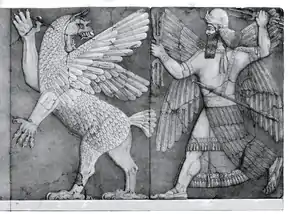Ušumgallu
Ušumgallu or Ushumgallu[2] (Sumerian: 𒁔𒃲ušum.gal, "Great Dragon")[5] was one of the three horned snakes in Akkadian mythology, along with the Bašmu and Mušmaḫḫū. Usually described as a lion-dragon demon,[1] it has been somewhat speculatively identified with the four-legged, winged dragon of the late 3rd millennium BCE.
| Part of a series on |
| Ancient Mesopotamian religion |
|---|
 Chaos Monster and Sun God |
| Related topics |
Mythology
Tiamat is said to have "clothed the raging lion-dragons with fearsomeness" in the Epic of Creation, Enuma Elish. The god Nabû was described as "he who tramples the lion-dragon" in the hymn to Nabû.[6] The late neo-Assyrian text "Myth of the Seven Sages" recalls: "The fourth (of the seven apkallu's, "sages", is) Lu-Nanna, (only) two-thirds Apkallu, who drove the ušumgallu-dragon from É-ninkarnunna, the temple of Ištar of Šulgi."[7]
Aššur-nāṣir-apli II placed golden icons of ušumgallu at the pedestal of Ninurta.[8] Its name became a royal and divine epithet, for example: ušumgal kališ parakkī, "unrivaled ruler of all the sanctuaries".[9] Marduk is called "the ušumgallu-dragon of the great heavens".
See also
- Anzû, a massive bird whose death was sometimes credited to Ninurta
- Dragon, killed by Ninurta
- Seven-headed serpent, killed by Ninurta
References
- ušumgallu, CAD U/W, pp. 330–331.
- Syllablized as Ú-šum-gal-lu.[1]
- F. A. M. Wiggermann (1992). Mesopotamian Protective Spirits: The Ritual Texts. Styx Publications. p. 167.
- Irene Winter (2009). On Art in the Ancient Near East: Of the First Millennium B.C.E, Volume 1. Brill. pp. 28–29.
- Wiggermann instead proposes "prime venomous snake”.[3] Winter translated it as "predator".[4]
- KAR 104, 29.
- E. Reiner (1961). "The Etiological Myth of the "Seven Sages"". Orientalia (30): 1–11.
- A. Leo Oppenheim (2011). "Assyrian and Babylonian Historical Texts: The Banquet of Ashurnasirpal II". In James Bennett Pritchard (ed.). The Ancient Near East: An Anthology of Texts and Pictures. Princeton University Press. p. 253.
- Kyle Greenwood (2011). "A Shuilla: Marduk 2". In Alan Lenzi (ed.). Reading Akkadian prayers and hymns : an introduction. SBL. pp. 317, 323.
